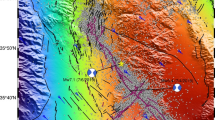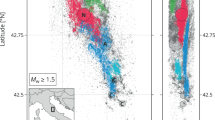Abstract
The Gutenberg–Richter (G–R) relationship can be derived as the Gibbs distribution. For a given earthquake set (all earthquakes in a given region, time period, magnitude range, tectonic settings) the Gibbs probability density function for magnitudes, with a given b value in its exponent, is the most uniform distribution under the constraints of the magnitude range and mean value. Therefore, it represents our limited knowledge about the system output: the only pieces of information are the mean value and the magnitude range. Honest earthquake forecasts can be based on such a distribution, since it represents all and only available information about the seismic system. The b value can change among different earthquake sets (in time, space, magnitude ranges, or tectonic settings), since it is related to earthquake rupture dynamics, or seismic source characteristics. The relationship between the b value and the exponent \(\beta\) in the rupture area vs. maximum slip scaling, \(A\propto D^{\beta }\), results from viewing earthquake recurrence time in connection with the slip budget. This makes a link between earthquake statistics (the G–R law) and physics (fault characteristics). Specifically, the relationship enables us to explain different ranges of b values at megathrust faults, in dependence on interplate asperity and coupling distributions, as well as on amounts of sediments and fluids in subduction channels. The approach differs from common interpretations of the G–R law in that the b value becomes a field variable, not a constant. It is always the Gibbs distribution for a given magnitude range that we use due to our ignorance about the system outcome, and it is the b value that variates, depending on our knowledge about the system physics. This is important for seismic forecasts, which are mostly based on the G–R relationship. First, because the physical processes leading to the largest earthquakes can be revealed by observing the b value variations. Second, because earthquake generation process can be thought of as sampling with constraints, where the b value and the magnitude range are the constraints.






Similar content being viewed by others
References
Allen, T. I., & Hayes, G. P. (2017). Alternative rupture-scaling relationships for subduction interface and other offshore environments. Bulletin of the Seismological Society of America, 107, 1240–1253.
Archuleta, R. J., & Ji, C. (2016). Moment rate scaling for earthquakes 3.3M5.3 with implications for stress drop. Geophysical Research Letters, 43, 12004–12011.
Berrill, J. B., & Davis, R. O. (1980). Maximum entropy and the magnitude distribution. Bulletin of the Seismological Society of America, 70, 1823–1831.
Boatwright, J. (1988). The seismic radiation from composite models of faulting. Bulletin of the Seismological Society of America, 78, 489–508.
Bürgmann, R. (2018). The geophysics, geology and mechanics of slow fault slip. Earth and Planetary Science Letters, 495, 112–134.
El-Isa, Z., & Eaton, D. W. (2014). Spatiotemporal variations in the b-value of earthquake magnitude–frequency distributions: Classification and causes. Tectonophysics, 615, 1–11.
Frohlich, C., & Davis, S. D. (1993). Teleseismic b values; Or, much ado about 1.0. Journal of Geophysical Research, 98, 631–644.
Gibowicz, S. J. (1973). Variations of the frequency–magnitude relation during earthquake sequences in New Zealand. Bulletin of the Seismological Society of America, 63, 517–528.
Gusev, A. A. (1988). Multiasperity fault model and the nature of short-period subsources. Pure and Applied Geophysics, 130, 635–660.
Gusev, A. A. (2013). High-frequency radiation from an earthquake fault: A review and a hypothesis of fractal rupture front geometry. Pure and Applied Geophysics, 170, 65–93.
Gutenberg, B., & Richter, C. F. (1942). Earthquake magnitude, intensity, energy and acceleration. Bulletin of the Seismological Society of America, 32, 163–191.
Hashimoto, C., Noda, A., & Matsu’ura, M. (2012). The Mw 9.0 northeast Japan earthquake: Total rupture of a basement asperity. Geophysical Journal International, 189(1), 1–5. https://doi.org/10.1111/j.1365-246X.2011.05368.x.
Hayes, G. P. (2017). The finite, kinematic rupture properties of great-sized earthquakes since 1990. Earth and Planetary Science Letters, 468, 94–100.
Heuret, A., Conrad, P., Funiciello, F., Lallemand, S., & Sandri, L. (2012). Relation between subduction megathrust earthquakes, trench sediment thickness and upper plate strain. Geophysical Research Letters, 39, L05304. https://doi.org/10.1029/2011GL050712.
Jaynes, E. T. (2007). Probability theory: The logic of science (edited by G. Larry Bretthorst). Cambridge: Cambridge University Press.
Johnson, K. M., Fukuda, J., & Segall, P. (2012). Challenging the rate-state asperity model: Afterslip following the 2011 M9 Tohoku-oki, Japan, earthquake. Geophysical Research Letters, 39, L20302. https://doi.org/10.1029/2012GL052901.
Kagawa, T., Irikura, K., & Somerville, P. G. (2004). Differences in ground motion and fault rupture process between the surface and buried rupture earthquakes. Earth Planets Space, 56, 3–14.
Katayama, I., Iwata, M., Okazaki, K., & Hirauchi, K.-I. (2013). Slow earthquakes associated with fault healing on a serpentinized plate interface. Scientific Reports, 3, 1784. https://doi.org/10.1038/srep01784.
Kennett, B. L. N., Gorbatov, A., & Kiser, E. (2012). Structural controls on the Mw 9.0 2011 Offshore-Tohoku earthquake. Earth and Planetary Science Letters, 310, 462–467.
Lay, T., Kanamori, H., & Ruff, L. (1982). The asperity model and the nature of large subduction zone earthquake occurrence. Earthquake Prediction Research, 1, 3–71.
Loveless, J. P., & Meade, B. J. (2011). Spatial correlation of interseismic coupling and coseismic rupture extent of the 2011 MW = 9.0 Tohoku-oki earthquake. Geophysical Research Letters, 38, L17306. https://doi.org/10.1029/2011GL048561.
Main, I. G., & Burton, P. W. (1984). Information theory and the earthquake frequency–magnitude distribution. Bulletin of the Seismological Society of America, 74, 1409–1426.
Maury, J., Aochi, H., & Radiquet, M. (2014). Fault constitutive relations inferred from the 2009–2010 slow slip event in Guerrero, Mexico. Geophysical Research Letters,. https://doi.org/10.1002/2014GL060691.
Moreno, M., Rosenau, M., & Oncken, O. (2010). 2010 Maule earthquake slip correlates with pre-seismic locking of Andean subduction zone. Nature, 467, 198–202.
Nanjo, K. Z., Hirata, N., Obara, K., & Kasahara, K. (2012). Decade-scale decrease in b value prior to the M9-class 2011 Tohoku and 2004 Sumatra quakes. Geophysical Research Letters, 39, L20304.
Nuannin, P., Kulhanek, O., & Persson, L. (2005). Spatial and temporal b value anomalies preceding the devastating off coast of NW Sumatra earthquake of December 26, 2004. Geophysical Research Letters, 32, L11307. https://doi.org/10.1029/2005GL022679.
Papadopoulos, G. A., & Minadakis, G. (2016). Foreshock patterns preceding great earthquakes in the Subduction Zone of Chile. Pure and Applied Geophysics, 173, 3247–3271.
Peng, Z., & Gomberg, J. (2010). An integrated perspective of the continuum between earthquakes and slow-slip phenomena. Nature Geoscience, 3, 599–607.
Scholz, C. H. (1968). The frequency–magnitude relation of microfracturing in rock and its relation to earthquakes. Bulletin of the Seismological Society of America, 58, 399–415.
Scholz, C. H. (1998). Earthquakes and friction laws. Nature, 391, 37–42.
Scholz, C. H., & Campos, J. (2012). The seismic coupling of subduction zones revisited. Journal of Geophysical Research, 117, B05310. https://doi.org/10.1029/2011JB009003.
Scholz, C. H., & Small, C. (1997). The effect of seamount subduction on seismic coupling. Geology, 25, 487–490. https://doi.org/10.1130/0091-7613.
Schurr, B., Asch, G., Hainzl, S., Bedford, J., Hoechner, A., Palo, M., et al. (2014). Gradual unlocking of plate boundary controlled initiation of the 2014 Iquique earthquake. Nature, 512, 299–302.
Senatorski, P. (2002). Slip-weakening and interactive dynamics of an heterogeneous seismic source. Tectonophysics, 344, 37–60.
Senatorski, P. (2014). Radiated energy estimations from finite-fault earthquake slip models. Geophysical Research Letters, 41, 3431–3437.
Senatorski, P. (2017). Effect of slip-area scaling on the earthquake frequency–magnitude relationship. Physics of the Earth and Planetary Interiors, 267, 41–52.
Senatorski, P. (2019). Effect of slip-weakening distance on seismic–aseismic slip patterns. Pure and Applied Geophysics, 176, 3975–3992. https://doi.org/10.1007/s00024-019-02094-7.
Shcherbakov, R., Goda, K., Ivanian, A., & Atkinson, G. M. (2013). Aftershock statistics of major subduction earthquakes. Bulletin of the Seismological Society of America, 103, 3222–3234.
Shen, P. Y., & Mansinha, L. (1983). On the principle of maximum entropy and the earthquake frequency–magnitude relation. Geophysical Journal of the Royal Astronomical Society, 74, 777–785.
Soquet, A., Valdes, J. P., Jara, J., Cotton, F., Walpersdorf, A., Cotte, N., et al. (2017). An 8 month slow slip event triggers progressive nucleation of the 2014 Chile megathrust. Geophysical Research Letters,. https://doi.org/10.1002/2017GL073023.
Somerville, P. G., Irikura, K., Graves, R., Sawada, S., Wald, D., Abrahamson, N., et al. (1999). Characterizing earthquake slip models for the prediction of strong ground motion. Seismological Research Letters, 70, 59–80.
Tassara, A., Soto, H., Bedford, J., Moreno, M., & Baez, J. C. (2016). Contrasting amount of fluids along the megathrust ruptured by the 2010 Maule earthquake as revealed by a combined analysis of aftershocks and afterslip. Tectonophysics, 671, 95–109.
Uchida, N., & Matsuzawa, T. (2011). Coupling coefficient, hierarchical structure, and earthquake cycle for the source area of the 2011 off the Pacific coast of Tohoku earthquake inferred from small repeating earthquake data. Earth Planets Space, 63, 675–679. https://doi.org/10.5047/eps.2011.07.006.
Vannucchi, P., Sage, F., Phipps Morgan, J., Remitti, F., & Collot, J.-Y. (2012). Toward a dynamic concept of the subduction channel at erosive convergent margin with implications for interplate material transfer. Geochemistry, Geophysics, Geosystems, 13, Q02003. https://doi.org/10.1029/2011GC003846.
Vannucchi, P., Spagnuolo, E., Aretusini, S., Di Toro, G., Ujiie, K., Tsutsumi, A., et al. (2017). Past seismic slip-to-the-trench recorded in Central America megathrust. Nature Geoscience, 10, 935–940. https://doi.org/10.1038/s41561-017-0013-4.
Vorobieva, I., Shebalin, P., & Narteau, C. (2016). Break of slope in earthquake size distribution and creep rate along the San Andreas Fault system. Geophysical Research Letters, 43, 6869–6875. https://doi.org/10.1002/2016GL069636.
Wang, K., & Bilek, S. L. (2011). Do subducting seamounts generate or stop large earthquakes? Geology, 39, 819–822. https://doi.org/10.1130/G31856.1.
Wells, L., & Coppersmith, K. J. (1994). New empirical relationships among magnitude, rupture length, rupture width, rupture area, and surface displacement. Bulletin of the Seismological Society of America, 84, 974–1002.
Wiemer, S., & Schorlemmer, D. (2007). ALM: An asperity-based likelihood model for California. Seismological Research Letters, 78, 134–140.
Wiemer, S., & Wyss, M. (1997). Mapping the frequency-magnitude distribution in asperities: An improved technique to calculate recurrence times? Journal of Geophysical Research, 102, 15115–15128.
Ye, L., Lay, T., & Kanamori, H. (2018). Global variations of large megathrust earthquake rupture characteristics. Science Advances, 4, eaao4915.
Zhao, D., Huang, Z., Umino, N., Hasegawa, A., & Kanamori, H. (2011). Structural heterogeneity in the megathrust zone and mechanism of the 2011 Tohoku-oki earthquake (Mw 9.0). Geophysical Research Letters, 38, L17308. https://doi.org/10.1029/2011GL048408.
Acknowledgements
Constructive comments by the Kojiro Irikura and the other Guest Editors, as well as three anonymous reviewers helped me to improve the manuscript. This work was partially supported within statutory activities no. 3841/E-41/S/2018 of the Ministry of Science and Higher Education of Poland.
Author information
Authors and Affiliations
Corresponding author
Additional information
Publisher's Note
Springer Nature remains neutral with regard to jurisdictional claims in published maps and institutional affiliations.
Rights and permissions
About this article
Cite this article
Senatorski, P. Gutenberg–Richter’s b Value and Earthquake Asperity Models. Pure Appl. Geophys. 177, 1891–1905 (2020). https://doi.org/10.1007/s00024-019-02385-z
Received:
Revised:
Accepted:
Published:
Issue Date:
DOI: https://doi.org/10.1007/s00024-019-02385-z




